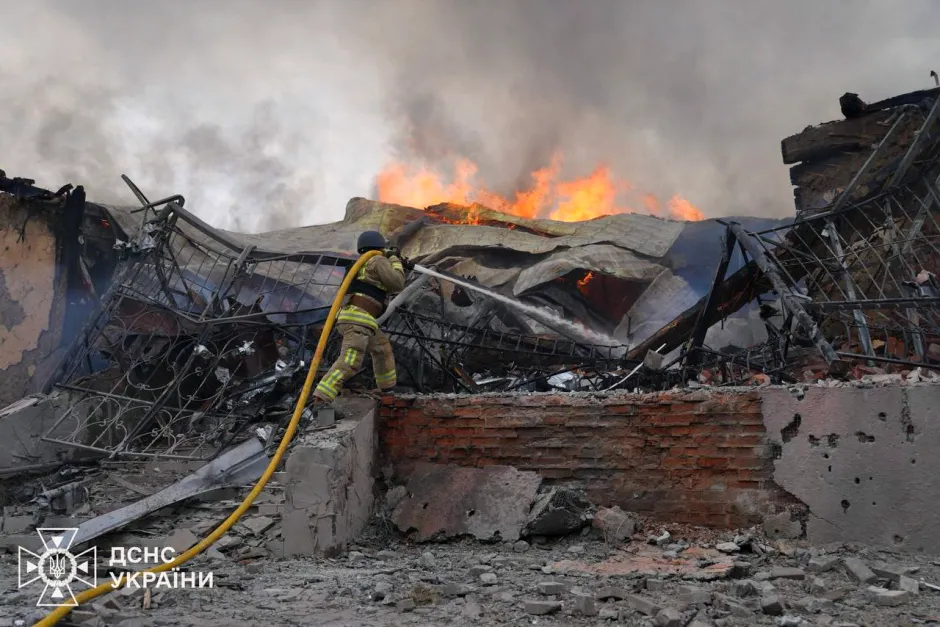KYIV, Ukraine — Vladimir Putin unleashed one of the largest drone assaults of the war on Ukraine early Sunday, striking multiple cities with more than 100 Iranian-made Shahed drones just hours after publicly calling for direct peace talks “without preconditions.”

The nighttime barrage struck civilian and military infrastructure in Kyiv, Mykolaiv, Zhytomyr and Donetsk, dashing hopes for a potential ceasefire as Ukrainian President Volodymyr Zelensky and Western leaders awaited a formal response to a 30-day truce ultimatum.
Ukraine’s Air Force Command reported that 108 drones and drone decoys were launched beginning around 2 a.m. local time. Ukrainian air defenses shot down 60 attack drones and neutralized 41 decoys. Despite those defenses, explosions rocked neighborhoods in the capital and surrounding regions, injuring at least one elderly civilian and damaging infrastructure, including a suspected air base.
The attack followed a 1 a.m. Moscow press conference in which Putin rejected a Western-backed ceasefire proposal but said he was open to restarting negotiations in Istanbul on Thursday. Kremlin adviser Yuri Ushakov confirmed that talks would factor in both the current battlefield dynamics and the stalled peace efforts from 2022.
Zelensky responded Sunday by reiterating Ukraine’s willingness to negotiate if Russia commits to a full and verifiable ceasefire starting Monday. “The first step to ending the war is a ceasefire,” Zelensky said. “There is no justification for continued killing.”
But instead of halting hostilities, Russian forces escalated. The drone strike came less than 24 hours after leaders from the United Kingdom, France, Germany and Poland issued a 24-hour deadline for Putin to accept a 30-day ceasefire or face expanded sanctions, including restrictions on oil exports and financial institutions. The leaders, meeting in Kyiv, also pledged increased military support for Ukraine if Russia refuses.
British Prime Minister Sir Keir Starmer said, “We are calling Putin out. It’s time to win the battle for peace. If he refuses, Ukraine will be armed to the teeth.”
French President Emmanuel Macron described Putin’s overture as “a first but insufficient step,” insisting that negotiations cannot precede an unconditional cessation of hostilities.
President Donald Trump, who joined the European leaders via a secure call, endorsed the peace push and said in a statement, “A potentially great day for Russia and Ukraine… I will continue to work with both sides to make sure it happens.”
Despite Putin’s stated readiness for talks, his government has continued to accuse Ukraine and its Western allies of prolonging the conflict. “Our proposal is on the table,” Putin said, blaming Ukraine and its supporters for choosing escalation. “They want to continue the war through the hands of Ukrainian nationalists.”
Putin’s approach has been widely viewed as a diplomatic trap—offering negotiations while escalating military pressure. Ukrainian officials warn that agreeing to talks under active bombardment would set a dangerous precedent and expose the country to future attacks.
Adding to the tension, U.S. intelligence agencies warned of a potential large-scale Russian airstrike on Kyiv this week. Russia is also expected to close airspace above its Kapustin Yar missile testing facility on Monday, further fueling fears of escalation.
Meanwhile, Russia’s ongoing aggression continued over the weekend, with reports of airstrikes violating a previously declared Victory Day ceasefire. Dmitry Rogozin, a former Russian space chief and prominent ally of Putin, signaled the Kremlin’s hardening stance, stating: “The curtseys are over. The usual combat work has begun.”
Ukrainian officials and international monitors have expressed skepticism about Putin’s intentions, citing a long pattern of negotiating under fire. The civilian toll continues to rise, and the drone attacks have reignited fears of another wave of intensified Russian assaults across the country.


